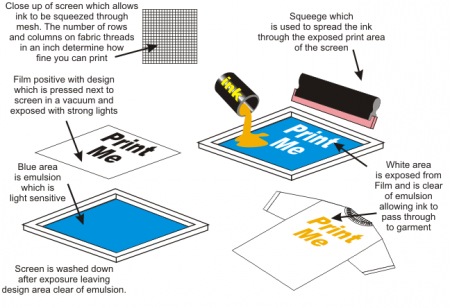The Definitive Guide for Tx Tees
The Definitive Guide for Tx Tees
Blog Article
Some Known Details About Tx Tees
Table of ContentsThe Definitive Guide to Tx TeesSome Known Details About Tx Tees Tx Tees for DummiesThe Single Strategy To Use For Tx TeesOur Tx Tees DiariesExcitement About Tx TeesThe Ultimate Guide To Tx Tees
That brings your total amount to about $1,900 gross and delivery. Include up other prices, like the variety of energies it takes to run the store and the cost of ink and emulsion per design. custom screen printing. Take the print below. This is a one-color photo, so the expense of ink per t-shirt is roughly 20 cents.The solution must just be a couple of cents given that you 'd just require to layer one display for this work. Generally, printers try to make up to 45% earnings on a print work.

With DTF, you can print a handful of shirts, or just one. Make use of the exact same calculator as the section over to determine just how much profit you would certainly use DTF transfers. Contrast the costs and profits to whichever approach speaks best to your arrangement and process. Both screen printing and DTF have their particular niches worldwide.
The Definitive Guide for Tx Tees
The ideal method to recognize? Ask around and see what print stores like yours are doing. custom monograming. Try both out and see which you like much better
When you're selecting what sort of printing technique to utilize for publishing your art work layouts on your garments, it is necessary that you understand the distinctions in between these 2 strategies so you can make the most of results while reducing prices. Display printing is the most commonly used technique for publishing styles on textiles.
DTG printing is additionally referred to as place or straight to garment printing due to the fact that it prints only what is needed instead of making a screen as display printers do. https://trello.com/u/txtees02/activity. Screen printing functions by screen filler squeegee display printing ink display mesh screen, after that transferring the photo to garment utilizing warm and/or stress
The DTG printer uses special dye-sublimation inks that are used right into a pre-designed picture by a digital printing system. The inks become component of the fabric, permitting vibrant shades and extraordinary detail. It's likewise referred to as spot or straight to garment printing since it publishes only what is required rather of making a screen as screen printers do.
Tx Tees Can Be Fun For Everyone
It's much quicker - you can print a fullcolor picture in mins, as opposed to hours for display printing. Second, there's no established up time or expenses entailed - you can print any design you like, without having to produce a screen first. Third, there's no waste - because screen printers screen print one design at once, they need to evaluate each shade independently.
The paper is really costly and can just be utilized when. Once it's printed on, it needs to be discarded. - The preliminary purchase cost is lower than the in advance investment of DTG printers- You can print multi-color designs one display each time rather than having to print each shade independently like DTG printing.

Tx Tees Fundamentals Explained
Instead of utilizing display mesh as screen printers do, color sublimation printers use laser innovation to move your photos onto garments or paper. A warmth process transfers the dye from its solid-state straight right into the gas stage which in turn merges it onto material substratums when they are swiftly warmed to high temperature levels under high stress.
Sublimation printing is eco-friendly. It utilizes less water than screenprinting, and since it does not entail using hazardous solvents, it's risk-free for all types of apparel. The dye sublimation inks are likewise odor-free when healed, unlike screen printers that use damaging chemicals throughout the display printing process that leave an undesirable smell.
They additionally conserve cash on pricey equipment like exposure units since dye sublimation printers don't require a UV exposure unit or a flash cure oven that is normally utilized in screen printing (custom cap printing). What is direct to garment printing (DTG Printing)? DTG printing is a digital screenprinting procedure that publishes directly onto fabric making use of specialized inkjet printers
Tx Tees Things To Know Before You Get This
DTG printing uses many advantages over standard screenprinting, including the ability to publish photo high quality images, better color vibrancy, and the capacity to print layouts on darker materials. DTG printers work by heating up the textile ink until it develops into a gas. The gas then penetrates the fabric, bonding with the fibers to create a permanent print.

Screen printers merely prepare their screen then begin publishing till they lack product or ink.- There is a wide variety of skilled screen printers all over the globe, which can be helpful for beginners. - It's a slower procedure - display printers commonly need to wait on the ink to dry before they can publish the following color- Screen printers call for hand-operated labor, so there's a greater knowing curve and it takes longer to generate a high-grade layout- Display printing isn't as precise as DTG printing, so you may obtain some "bleeding" of shades from one component of the picture onto another otherwise done appropriately.
Fascination About Tx Tees
Instead of making use of display mesh as screen printers do, dye sublimation printers utilize laser technology to move your images onto garments or paper. A warm process transfers the dye from its solid-state directly right into the gas stage which in turn fuses it onto fabric substrates when they are quickly heated up to high temperatures under high pressure.
Sublimation printing is environment-friendly. It uses much less water than screenprinting, and due to the fact that it doesn't include using damaging solvents, it's secure for all kinds of clothing. The color sublimation inks are also odor-free when healed, unlike screen printers that use dangerous chemicals during the display printing process that leave an undesirable smell.
They additionally save cash on pricey tools like exposure units because color sublimation printers do not call informative post for a UV direct exposure device or a flash treatment stove that is commonly used in screen printing. What is direct to garment printing (DTG Printing)? DTG printing is a digital screenprinting procedure that prints directly onto fabric using specialized inkjet printers.
Tx Tees Fundamentals Explained
DTG printing uses numerous benefits over traditional screenprinting, consisting of the ability to print photographic top quality photos, greater color vibrancy, and the ability to publish layouts on darker materials. DTG printers work by heating the fabric ink up until it becomes a gas. The gas after that permeates the textile, bonding with the fibers to develop a long-term print.
Report this page